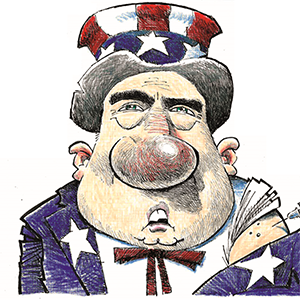Movie review: 'The Luckiest Man in America' goes behind scenes of game show scandal
Published in Entertainment News
“The Luckiest Man in America” is an ironic title for the story of Michael Larson, the Ohio man who managed to win over $110,000 on a 1984 episode of the game show “Press Your Luck.” The truth is, luck had nothing to do with it. Larson, played here by Paul Walter Hauser, had memorized the five patterns of seemingly random blinking lights on the Big Board, successfully avoided whammies, and took CBS for an unprecedented sum. As depicted in Samir Oliveros’ film inspired by this odd moment in television history, the “luckiest man” title was hastily brainstormed by the panicking producers backstage, hoping to spin their expensive oversight into TV gold.
Written by Oliveros and Maggie Briggs, it’s this corporate-crafted “luckiest man” myth that’s at the heart of their argument, a sharp critique of the mediated falsehoods disseminated to make us believe that striking it rich is just a matter of having the willingness to be a contestant on a game show — fame and fortune only a few spins away.
Larson’s story has been made into a couple of Game Show Network documentaries, a Spanish-language graphic novel, and now “The Luckiest Man in America,” which extrapolates some of the control room and behind-the-scenes events from that day, taking inspiration from the 42 minutes of TV footage of Larson, and using input from the son of producer Bill Carruthers (played by David Strathairn in the film). The writers acknowledge Larson’s seedy past with scams and schemes, but the film itself is laser-focused on the events of that day, illustrating all the moving parts of the television production and how this “scandal” came to be.
There is a palpably vintage quality to “The Luckiest Man in America,” obviously in the '80s costuming and hair, the sets and broadcast TV style. Cinematographer Pablo Lozano uses the color and flashing lights of the set to capture something almost surreal happening in this room, and blends mediums with picture-in-picture VHS home movies and re-creations of the show, seamlessly stitched together by editor Sebastian Hernandez. An electronic score by John Carroll Kirby apes the sound of the era but devolves into abstraction as the story develops into something darker.
But there’s also a 1990s/2000s throwback feel to this quirky dramedy featuring a large ensemble cast in this story about a forgotten 20th-century media tale. The obvious comparison is “Quiz Show,” Robert Redford’s 1994 best picture nominee about a 1950s quiz show scandal, but “The Luckiest Man in America” has a more comedic, kitschy quality with its feathered hairdos and bright retro aesthetic.
The humor also comes from star Hauser, who easily occupies the uneasy liminal space between comedy and drama. Hauser is a character actor-turned-leading man so specific that only he could do what he does, not just in persona but in performance. As Larson, he dials in to a level of detail in gesture and physicality that speaks volumes about the man and his mindset. He mouths the words to the show intro spoken by Peter Tomarken (Walton Goggins) and grasps the host’s hand meaningfully when they meet.
Hauser throws his head back in glee as Larson shouts “stop!” at each spin, not even looking at the board, his too-early celebrations a tipoff to producer Chuck (Shamier Anderson) who susses out that he’s essentially “counting cards” in the “Press Your Luck” casino. Hauser gives this head-toss an element of ecstasy as his Larson enters into a kind of Big Board flow state, dodging whammies even as the producers lob psychological obstacles his way in an attempt to throw him off.
Oliveros surrounds Hauser with a supporting cast of talented (and underrated) actors like Anderson, and Strathairn, who lends a sense of televisual gravitas that eventually melts away as his Carruthers proves to be a spineless exec who can’t stand by his decision to cast the shady Larson and throws his colleagues under the bus. Brian Geraghty and Patti Harrison lend some color to Ed and Janie, the contestants who have to standby and watch Larson’s unprecedented steamroll, while Goggins plays the perfect game show host. Maisie Williams and James Wolk are the harried production assistant and director trying to corral Larson, who alternates between trying to call his wife (Haley Bennett) in a panic and his gleeful, record-breaking sweep.
This is an American story made by an international cohort — Chilean filmmaker Pablo Larrain is an executive producer under his Fabula production banner — and the film is so much more than just an exploration of this anomalous oddball story and character who managed to outsmart the media. The focus on the control room panic illustrates how these corporate narratives shape the myth of the American dream, effectively deconstructing the fantasy that any of this was ever about luck at all.
———
'THE LUCKIEST MAN IN AMERICA'
3 stars (out of 4)
MPA rating: R (for language)
Running time: 1:30
How to watch: In theaters April 4
———
©2025 Tribune Content Agency, LLC













Comments